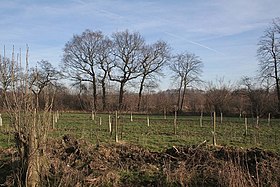
Back تشجير Arabic Урман ултыртыу Bashkir বনায়ন Bengali/Bangla Pošumljavanje BS Zalesňování Czech Coedwigo Welsh Tihi Sabu DAG Aufforstung German Forestación Spanish Metsastamine Estonian

Afforestation is the establishment of a forest or stand of trees (forestation) in an area where there was no recent tree cover.[1] In comparison, reforestation means re-establishing forest that have either been cut down or lost due to natural causes, such as fire, storm, etc.[2] There are three types of afforestation: Natural regeneration, agroforestry and tree plantations.[3] Afforestation has many benefits. In the context of climate change, afforestation can be helpful for climate change mitigation through the route of carbon sequestration. Afforestation can also improve the local climate through increased rainfall and by being a barrier against high winds. The additional trees can also prevent or reduce topsoil erosion (from water and wind), floods and landslides. Finally, additional trees can be a habitat for wildlife, and provide employment and wood products.[3]
Several countries have afforestation programs to increase carbon dioxide removal from forests and to reduce desertification. However, afforestation on grasslands and savanna areas can be problematic. Carbon sequestration estimates in those areas often do not include the full amount of carbon reductions in soils and slowing tree growth over time. Also afforestation can negatively affect biodiversity through increasing fragmentation and edge effects for the habitat remaining outside the planted area.
- ^ Terms and definitions – FRA 2020 (PDF). Rome: FAO. 2018. Archived (PDF) from the original on 9 August 2019.
- ^ "Reforestation - Definitions from Dictionary.com". dictionary.reference.com. Retrieved 27 April 2008.
- ^ a b Cite error: The named reference
:3was invoked but never defined (see the help page).
© MMXXIII Rich X Search. We shall prevail. All rights reserved. Rich X Search